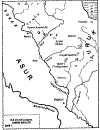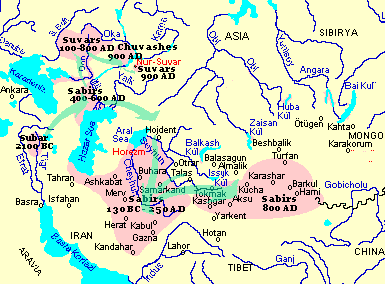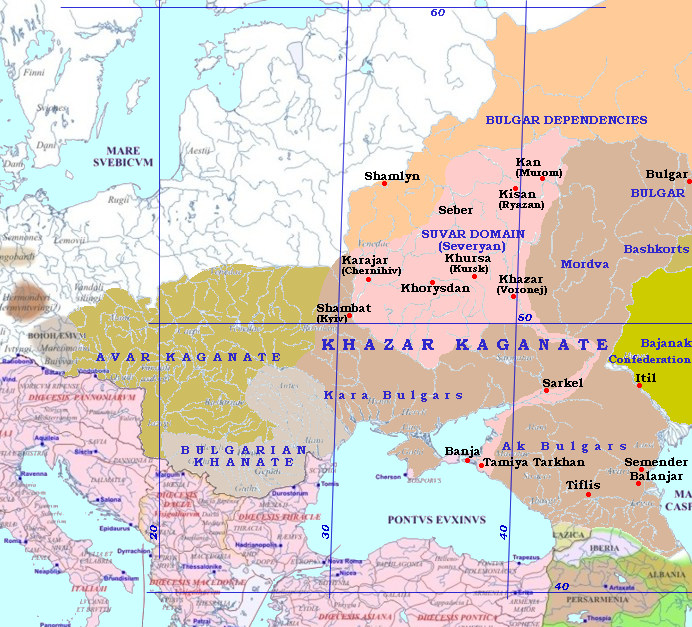| DATELINE |
| Time |
Events |
| 2,500 BC |
In the historical period, Sabirs had inglorious beginning. In earliest
Mesopotamia, the word “Subarian“ became a synonym for slave. Apparently, Sabirs were
kyshtyms of the Sumerian Kangars |
 |
| 750 BC |
Hesiod, 7th Century BC, writes: Inventors of bronze
working were Scythians. The early Mesopotamian name for metal is Zubur,
indicating that northern Mesopotamian Subartuans or a people of that
region were indeed inventors of process. |
 |
| 124 BC |
Sabir (Sabaroi) are allied with Asi (Ases, Yazig, or Asiani), and Tochars, break into Sogdiana and Bactria. In next five years
two Parthian emperors loose their lives in wars. Later Sakauraka (Türkic
‘Saka-farmers’) tribe is also conquered by them. Sakauraka may be any semi-sedentary
Saka people living in Aral, Sary-Kamysh, and Caspian river deltas who do not need to resort to meridional
or mountainous pasturing. “Saka” comes from the Türkic word saka ‘‘foothills’‘ [Kashgari, vol. 3, p. 246], in Türkic the words Togar
(Tochar, Tokhar) and Saka are synonymous, both meaning “Mountaineer”. |
 |
| 139 AD |
Ptolemy (83?-161? AD) writes that in European Sarmatia
‘below Agathyrsi (Akatsirs, Türkic agach ers ‘forest people’) live Savari
(Türkic Suvars), between Basternae and Rhoxolani (Tr. Uraksy Alans, i.e.
‘Alans-farmers’) live Huns |
 |
| 420 |
WHITE HUN EMPIRE 420 - 552 A.D
Founder - Aksuvar (Aksungur)
Area - Half of northern India, Afghanistan, parts of
Turkistan
(Total Area - 3,500,000 Km2) |
 |
| 450 |
Per Priscus, Sabirs conquered lands of Onogurs, Saragurs
and Ugors in steppes around north-western Caspian coast. |
| 453 |
After Atilla's death, by drawing lots, to Ellak, eldest of Atilla’s sons, was given
ulus (Oguz) of a horde called Sabirs. To Tengiz (DengizikDiggizikh), was given ulus
(Oguz) of a horde called Kutrigurs (Kuturgurs/Kotrags = West Wing, from köturi
= behind = “to the west“). To Bel-Kermek (Hernach/Irnik/Ernik), youngest, was
given ulus (Oguz) of a horde called Utigurs (Utragurs/Utigurs = East Wing, from
utra = front, opposite = “opposite side“ = “to the east“. This distribution
indicates that Sabirs were a Center Wing, called “otra“, extending from N.Caucasus
to Don and Seim rivers. |
| 454 |
Coalition of Germanic clans defeats and kills Ellak in
battle. Sabirs without Ellak retreat to the East, through Pontic Steppes,
to Daghestan. Kutriguri and Utiguri under Bel-Kermek (Hernach), fell back
to 'Ugol' (Ul = frontier) place that corresponds to Bessarabia. |
| 469 |
Western Hunnish clans retreated. Utigurs to Azov-Taman
SE of Sea of Azov. Kutrigurs to between Dniepr and Don Rivers, NW from Sea
of Azov Utigurs. Sabirs in Daghestan SE of other two Hunnic hordes, between
Daryal Gorge and Kuma River on the Caspian Sea. |
| 505 |
Sabirs from Pannonia begin to immigrate to North
Caucasus and Itil valley |
| 505 |
Sabirs created a powerful federation of akin tribes,
“Kingdom of Huns“. They were populous and had an army of 20,000
well equipped cavalrymen. They were masters of art of war and build siege
machines unknown even to Persians and Byzantines. 20,000 army indicates 90-100,000
strong tribe |
| 552 |
End of WHITE HUN (EPHTALITE) EMPIRE 420 - 552 A.D
Founder - Aksuvar (Aksungur)
Area - Half of northern India, Afghanistan, parts of
Turkistan
(Total Area - 3,500,000 Km2) |
 |
| 552 |
Sabirs switch from allying with Iran to Byzantine and
conquer Agvania. Byzantine conquer Italy |
| 554 |
Persians defeat Sabirs in Agvania. |
| 555 |
Date of Zacharias Rhetor list of thirteen Hun or Turkic peoples who live
in tents, No 3 is sbr Σάβιροι Sabirs Huns, or Huns-Savirs |
| 558 |
Avars first crushed Türkic Sabirs, allies of Byzantine,
who lived on Kuma river and in Dagestan. Avars then crushed Uturgurs, a
Bolgarian tribe and also allies of Byzantine, living between Itil and Don,
then crushed Zals and Ants on both sides of Don. |
| 558 |
Sabirs (Suvars) are scattered, Dagestani Savirs are not affected, but Don/Donets
Savirs pull back northward, to Chernigiv-Sever area. Sever is Sl. for Suvar |
| 558 |
Invading Avars attack Hunno-Bulgars. Utiguri, Kutriguri,
and Sabiri conquered (559-560). |
| 558 |
Avars defeat Sabirs in N Caucasus |
| 558 |
Avarian embassy to Byzantium. Avars defeat Sabirs and
Ants. |
| 560 |
Avar Kaganate extended from Itil to mouth of Danube.
Bolgars are split, with Kuturgur Huns (also listed are Onogundurs (10 Oghur
Confederation), Hunnogurs, Sabirs belonging to Avar Kaganate, and Utugur Huns (30 Oghur)
and Khazars loyal to W. Kaganate |
| 561 |
Sosroi Nushirvan crushes Sibirs |
| 565 |
Avars subjugate Hunnugur and Sabir, and other Hunnic
hordes, assimilating them under Avar Kaganate. |
| 565 |
After defeat of their forces by Avars, Khazars took lead
in Sabir-Khazar federation. Part of Sabirs move north, to Middle Itil
region, among settled there Bolgarian tribes. Their main city Suvar is a
great center of Itil Bolgaria. |
| 575 |
Byzantines entered Caucasian Albania in 575 to subdue residing there Savirs and Albans.
Savirs revolted against Byzantine domination and Byzantine generals came forced Savirs
and Alvans to move to this side of river Cyrus (Kura)
and henceforth remain in Roman country” |
 |
| 576 |
Embassy of Caucasian Savirs and Alans to Byzantine. Emperor Tiberius
(578-582) promised Savirs and Alans more favorable terms of alliance than Persian terms |
| 610 |
Future Gokturk’s Sibir-Khan (14), Mokhodu, of the most
western ulus, is baptized in Constantinople. This starts his fight with
Buri-shad (34) (610-618) and Tardu Yabgu (Tun(g)-Yabgu) (23) (618-630).
Kubrat is not baptized. |
| 630 |
Gokturk Kaganate’s Sibir-Khan (14) recognized independence of Bolgaria under Kubrat
of Dulo dynasty, his nephew of feminine line. Notably, the tribal symbols of the Dulo
clan of the Bulgars and the Qayn (Kayı) tribe of the Oguzes are the same |
 |
| 630 |
Qarluqs rebel against Gokturk Kaganate, Tung Yabgu (23)
dies, W. Kaganate split, SW and NE. SW run by Nushibis, under Irbis Bolun
Yabgu (31) (631-631), installed by Nishu Khan Shad (32), son of Baga Shad
(24). NE run by Tele (Dulu), under Sibir Khan Yabgu (14) (630-631). |
| 631 |
Irbis Bolun Yabgu (31) replaced by Nishu Khan Shad (32)
as Dulu Khan (631-634). Sibir Khan Yabgu (14) killed. W. Gokturk Kaganate
reunited. |
| 635 |
Kubrat escaped dominance of Gokturks and Khazars, by
supporting Sibir-Khan in 630. He became independent, defeated Avars.
Controlled area near Pontic steppes |
| 700 |
Sabirs are identified with Romny-Borshchev (8th-10th cc., Lipetsk, Voronej, Bryansk,
Kursk and Belgorod provinces) and Volyntsevo (8th-9th cc., between Dnieper and Don
rivers) cultures |
| 820 |
Sabirs are listed in Sogdian document found in Turfan, conditionally
named
Naf Namak,
Remnants of Sabirs remained in Turfan neighborhood long after 5th c. migrations, scholars
placed their home-country near Turfan, making Sabirs the known Türkic tribe that lived in
symbiosis with Kucha and Argi people (mislabeled “Tokharians”) |
 |
| 864 |
Between 864 and 884. First assault of Norman/Viking/Varyag/Ruses on Tabaristan
Province of Arab Caliphate with at least some Türkic population of Gilans, Kayi Huns,
Masguts, and Savirs. Ruses attacked largest southern port city Abaskun in Astrabad Bay,
reportedly Amir killed all Ruses. |
| 882 |
Salahbi Yolyg (aka Oleg, Oleg the Seer, Olaf, 882-912), Kyiv Ilchibek
(regent) for Igor (Ugyr Lachini, 912-945, aka Igor I the Old, Ingvar) set out
down river to capture Slavic Dnieper Krivicheys with their ruler's seat in
Shamlyn (future Smolensk), and then sailed down to Suvars (Slav. Severyans) and
took Lübech, the seat of ruling Khan Alabuga of Baryn line of Suvars.
Possibly one of captured Khan Alabuga's daughters became household slave in Salahbi Yolyg
household, Malusha intendant (keyholder) of Lübech, who later bore Kiev
Knyaz Vladimir. Mal is “cattle” in Türkic, with derivatives “wealth, money,
treasure”, Malusha is diminutive form with connotation “precious”, adopted by Slavs. Mal
was a popular name in pre-Hunnic n.Pontic. |
| 882 |
Khan Alabuga of a Baryn line of Sabans (Slavic “Berendeis) starts a city later
named Bilyar. |
| 884 |
Salahbi Yolyg (aka Oleg, Oleg the Seer, Olaf, 882-912), Kyiv Ilchibek
(regent) for Igor (Ugyr Lachini, 912-945, aka Igor I the Old, Ingvar) raids
Khazarian subjects Suvars (Slav. Severyans), defeats them and imposes a nominal
tribute, adding Suvars to his “Rus“ realm. Suvars split, one part remaining in
place, and part migrating NE to Itil-Kama interfluvial, area of future city Nur-Suvar |
| 895 |
Itil Bolgaria census lists 550K, 200K are Saban-speaking
Bulgars (Suvars), 180K-Ars (Udmurts, Finno-Ugors), 170K-Modjars (Mordva) |
| 907 |
Byzantine treaty of 907 with (Kyiv? Itil?) allocates a separate tribute
to capital of Suvars Chenigov (Karajar) |
| 909 |
Between 909 and 913. Second assault of Norman/Viking/Varyag/Ruses on
Tabaristan Province of Arab Caliphate with at least some Türkic population of Gilans,
Kayi Huns, Masguts, and Savirs. Ruses attacked again largest southern port city Abaskun
in Astrabad Bay, then Sari in Hyrcania (Yiyrks). Gilan force reportedly killed all Ruses. |
| 913 |
Largest campaign of Norman/Viking/Varyag/Ruses in Caspian, devastation of Gilan,
Deilem, Tabaristan, Abaskun, attacked Baku in Azerbaijan and Shirvan with significant
Türkic population of Gilans, Kayi Huns, Masguts, Yiyrks, Azeri, and Savirs. Khazars demolish Rus marauding expedition fleet |
 |
| 922 |
City Nur-Suvar founded (922-1246). Present name Tatarskiy
(Sham-Suar). |
| 930 |
Itil Bulgaria has 30 cities. Khasan built: Matak,
Nukrat, Bandja (Samara ) (Center of Mardan-Bellak ulus), Bulyar (citadel in
Bilyar), Kamysh, Simbir, Gazan-Deber, Kashan, Tukhcha, Tau-Kerman
(Sviyajsk), Tash-Bolgar, Subash-Simbir, Karadjar, Djilan |
| 943 |
Campaign of Norman/Viking/Varyag/Ruses in Caspian, capture of Agvan
capital Berdaa at a tributary of Kura in Azerbaijan, devastating city, but with large
losses. Agvan had significant Türkic population of Gilans, Kayi Huns, Masguts, Azeri, and
Savirs. |
| 964 |
Bulgarian annals provide background information on the Rus campaign against Khazaria, depicting it as a
Bulgar liberation war of joint Bulgar-Rus alliance, where Bulgaria paid Ruses for the
campaign by leasing out provinces Djir (future Rostov province and city of
Russia), Kan (future Murom province and city) and the western Kortdjak
(future Moscow, Vladimir and Ivanovo provinces), for an annual tribute equal in size to
the tribute from Djir (Bulgar-Rus Treaty of 964). In the campaign participated
Turkmens (Oguzes), recently defeated in the lengthy Bulgar-Turkmenian war (ca. 947-ca.
960), and Bajanaks, whose territory the Rus army had to cross, as Rus allies in the
campaign. The annals describe Rus army as consisting of 20 thousand Vikings and 50
thousand Slavs. |
| 966 |
Bandja (Fanagoria), capital of Great Bulgaria in VII c, destroyed by Kiev Knyaz
Svyatoslav. Escaped inhabitants established New Bandja in Jiguli on Itil
(Murom setlement). During campaign were devastated cities in the North-East Caucasus,
including Semender. |
| 977 |
Ibn Haukal (
Ibn Hawkal) in the “Face of the Earth“ records that Azeri and Persian
languages were being used as Lingua Franca across the Caucasus. Ibn Haukal mentiones
Azeri language as lingua franca across the Caucasus 2 centuries before Azeris reach
Caucasus in “consensus“ version of history |
| 1239 |
Batu and Yaroslav (Yaroslav Vsevolodovich, 1191—1246, brother and hair apparent of
Vladimir's Grand Prince Yury
Vsevolodovich) attack together Chernigiv principality (Chernigiv-Sever) |
| 1246 |
City Nur-Suvar destroyed (922-1246). Present name
Tatarskiy (Sham-Suar). |









